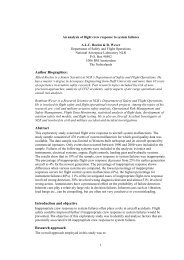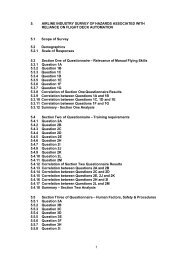Causal risk models of air transport - NLR-ATSI
Causal risk models of air transport - NLR-ATSI
Causal risk models of air transport - NLR-ATSI
You also want an ePaper? Increase the reach of your titles
YUMPU automatically turns print PDFs into web optimized ePapers that Google loves.
Fatal accidents are rare events. When using accident data (i.e. the realization <strong>of</strong><br />
probabilities) to quantify aviation <strong>risk</strong>, this must be taken into account. Because fatal<br />
accidents are so rare even large observed differences need not attain significance. If a coin<br />
is tossed only four times, then no possible outcome - even four heads or four tails- would<br />
provide statistically significant evidence that the coin is not f<strong>air</strong> [Czerwinski & Barnett<br />
2004]. The number <strong>of</strong> aviation accidents with fatalities has become so low that it is<br />
problematic to use those as the only indicator <strong>of</strong> <strong>air</strong> <strong>transport</strong> <strong>risk</strong>, there is too much<br />
randomness in the data. Therefore non-fatal accidents and incidents should be included in<br />
the considerations on the construction <strong>of</strong> a causal <strong>risk</strong> model. But the question then arises<br />
which occurrences should be considered. Incidents and (fatal) accidents are not necessarily<br />
causally related. Trips and falls for instance result in many injuries but are rarely causally<br />
related to catastrophic accidents. Therefore only those occurrences, associated with the<br />
operation <strong>of</strong> an <strong>air</strong>craft, which affect or could affect the safety <strong>of</strong> operation 7 should be<br />
included.<br />
2.4. Risk criteria<br />
Unfortunately, safety is not self-sustainable [SAE 2003]. Some sort <strong>of</strong> safety management<br />
is required to improve or even maintain the current level <strong>of</strong> safety. Policies to control major<br />
<strong>risk</strong>s have been in development from the 1960s onwards. Many <strong>of</strong> these policies are based<br />
on some sort <strong>of</strong> quantification <strong>of</strong> the <strong>risk</strong> that could be allowed to continue. This section<br />
explains how causal <strong>risk</strong> <strong>models</strong> can be used in relation to such quantitative <strong>risk</strong> criteria and<br />
<strong>risk</strong> control policies.<br />
A Target Level <strong>of</strong> Safety (TLS) is the ‘amount’ <strong>of</strong> safety that is aimed for. The concept <strong>of</strong> a<br />
TLS appears intuitively obvious [Joyce et al 2001]. The prime user <strong>of</strong> the TLS concept in<br />
aviation has been ICAO. Over the years, ICAO has developed TLS concepts in various<br />
safety critical areas <strong>of</strong> the industry, using international groups <strong>of</strong> experts. Such areas have<br />
included the North Atlantic System Planning Group (1992), the All Weather Operations<br />
Panel (1994), the Obstacle Clearance Panel (1980) and the Review <strong>of</strong> the General Concept<br />
<strong>of</strong> Separation Panel (1995). The latter work panel has <strong>of</strong>fered the following definition:<br />
“A Target <strong>of</strong> Safety (TLS) specifies an acceptable value <strong>of</strong> <strong>risk</strong> which can be used as a<br />
yardstick against which the <strong>risk</strong>s associated with a system or procedures can be evaluated.<br />
The concept <strong>of</strong> a TLS is particularly useful when planning changes in safety critical<br />
operations such as <strong>air</strong> traffic control.”<br />
[RGCSP 1995].<br />
The definition for the TLS concept that is <strong>of</strong>fered will vary in accordance with its particular<br />
application and its intended use. For example, the UK Civil Aviation Authority (an<br />
organisation which has also been instrumental in the development <strong>of</strong> TLS concepts),<br />
defines the TLS concept for controlled <strong>air</strong>space as:<br />
“…a fundamental concept in any mathematical / statistical approach to systems planning<br />
when questions <strong>of</strong> safety are involved…The target level <strong>of</strong> safety is the level <strong>of</strong> safety which<br />
the system is designed to achieve. Put the other way round, the system is designed to an<br />
assured level <strong>of</strong> safety. By this specification it is possible to define planning objectives<br />
which fit in with the safety constraints, and also provide a safety yardstick against which<br />
potential changes can be assessed and objectives pursued.” [Brooker & Ingham 1977].<br />
A Target Level <strong>of</strong> Safety is a level <strong>of</strong> safety that either must be achieved in order to carry<br />
out some activity (i.e. a mandatory target) or must be aimed for but need not necessarily be<br />
7<br />
This is ICAO’s definition <strong>of</strong> an ‘incident’.<br />
17




